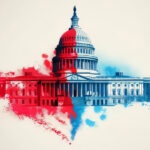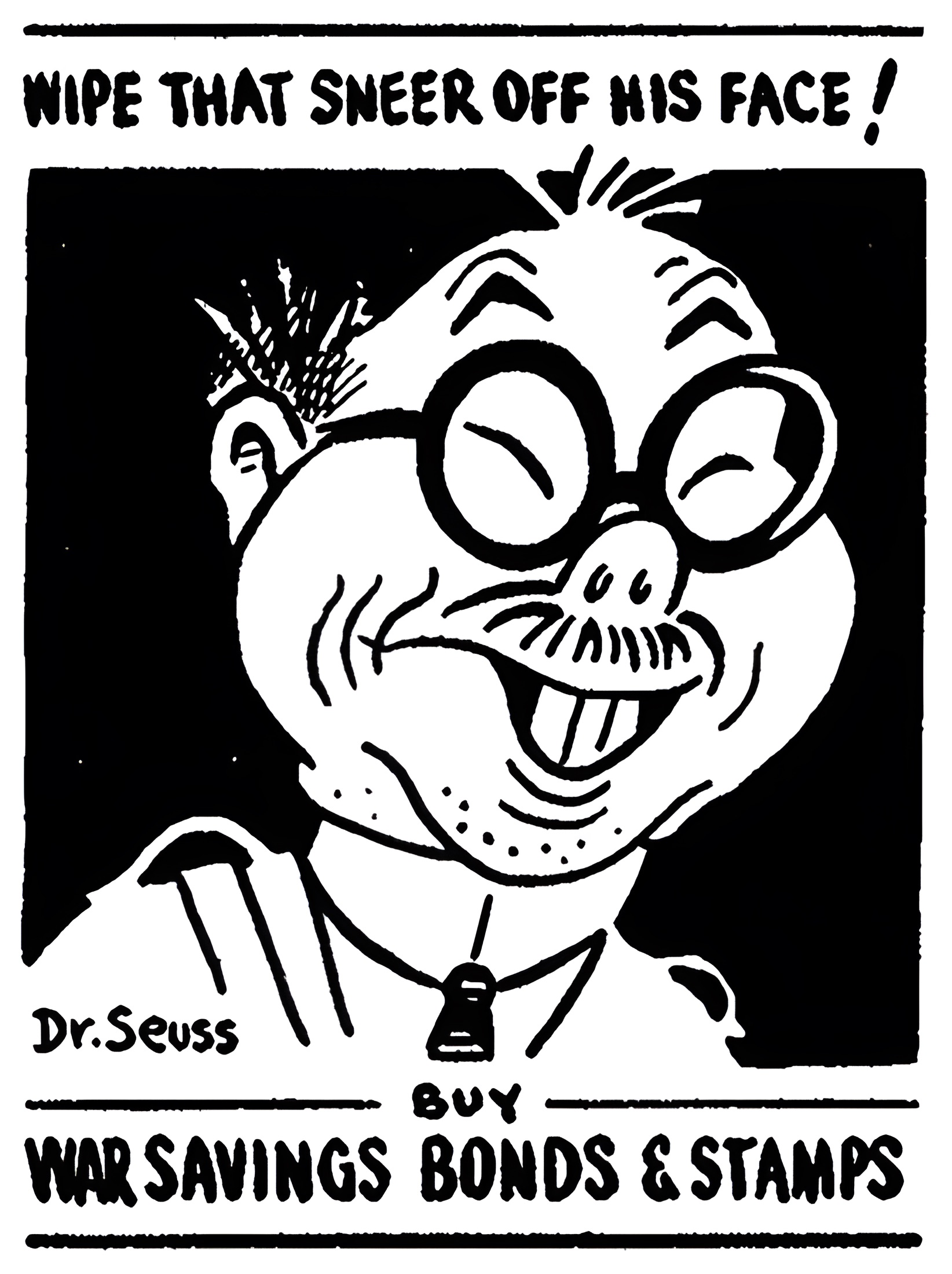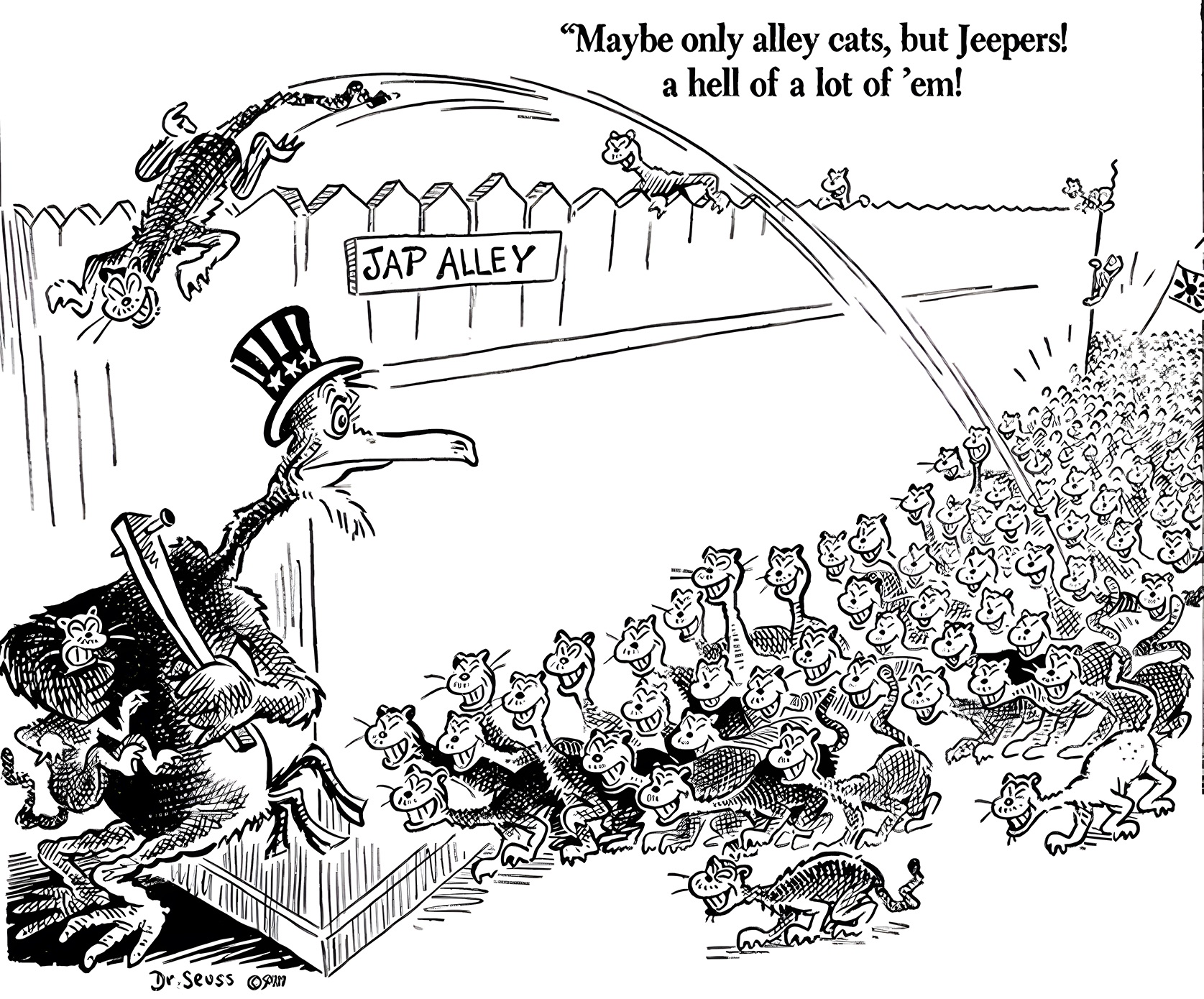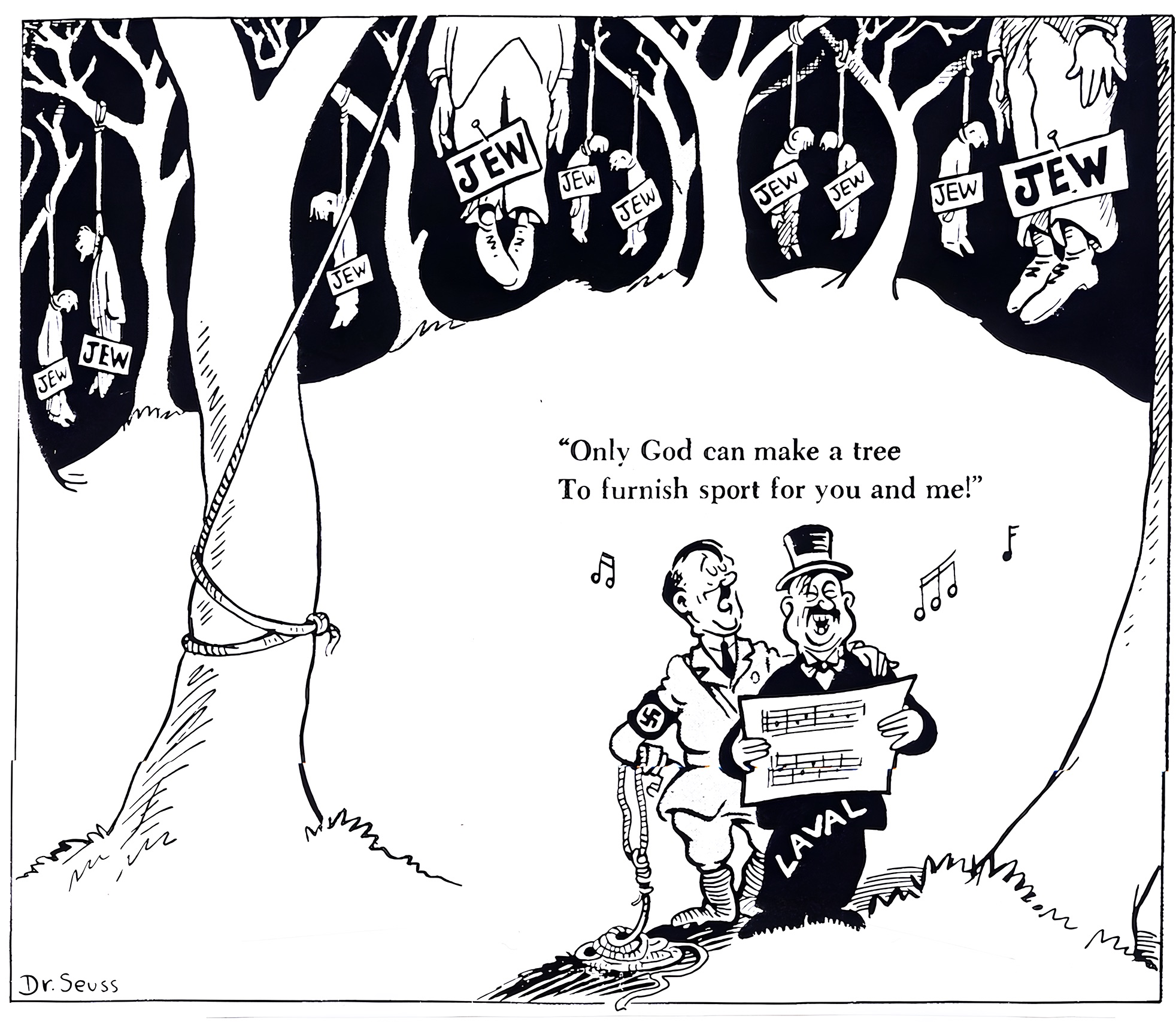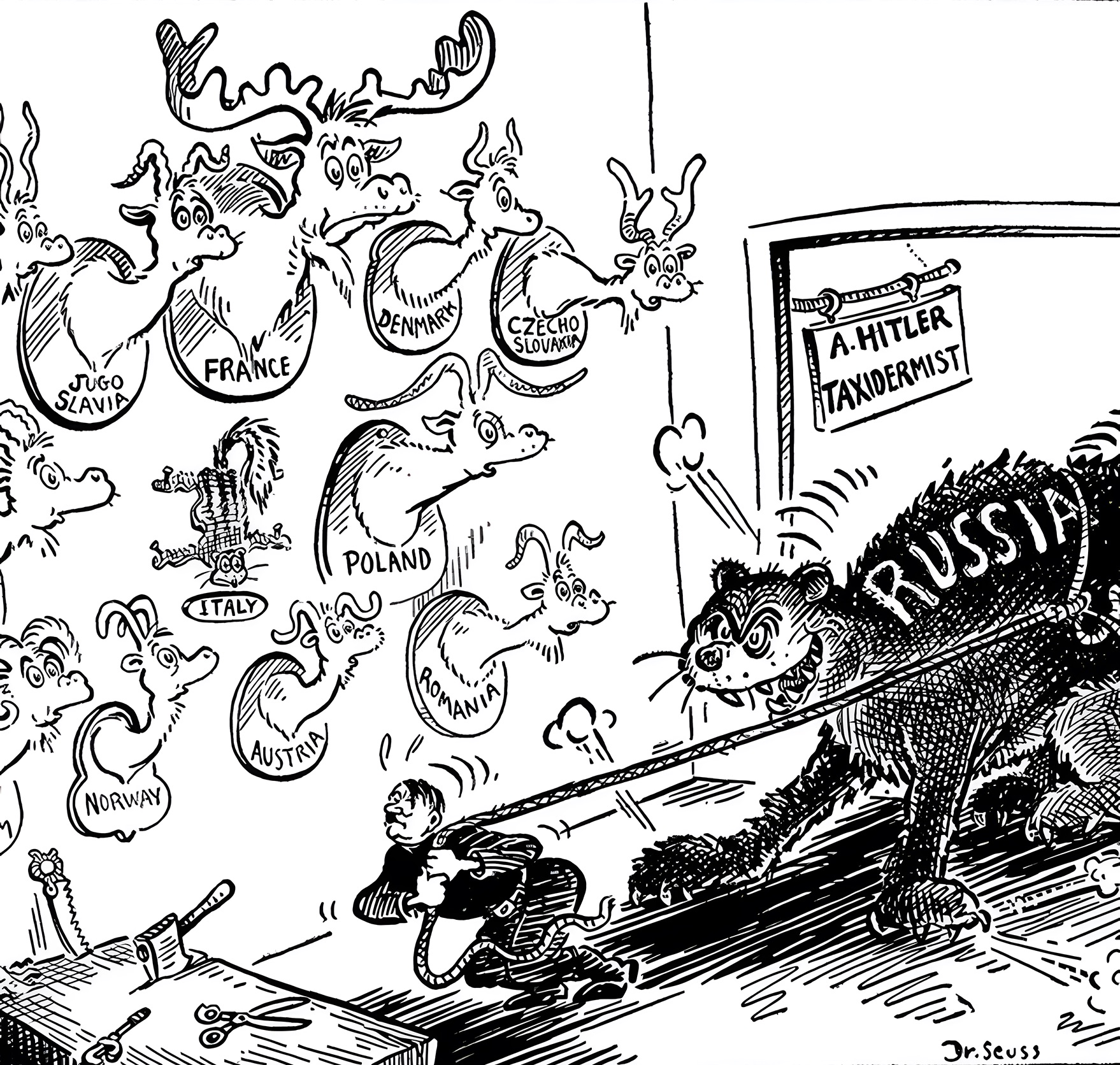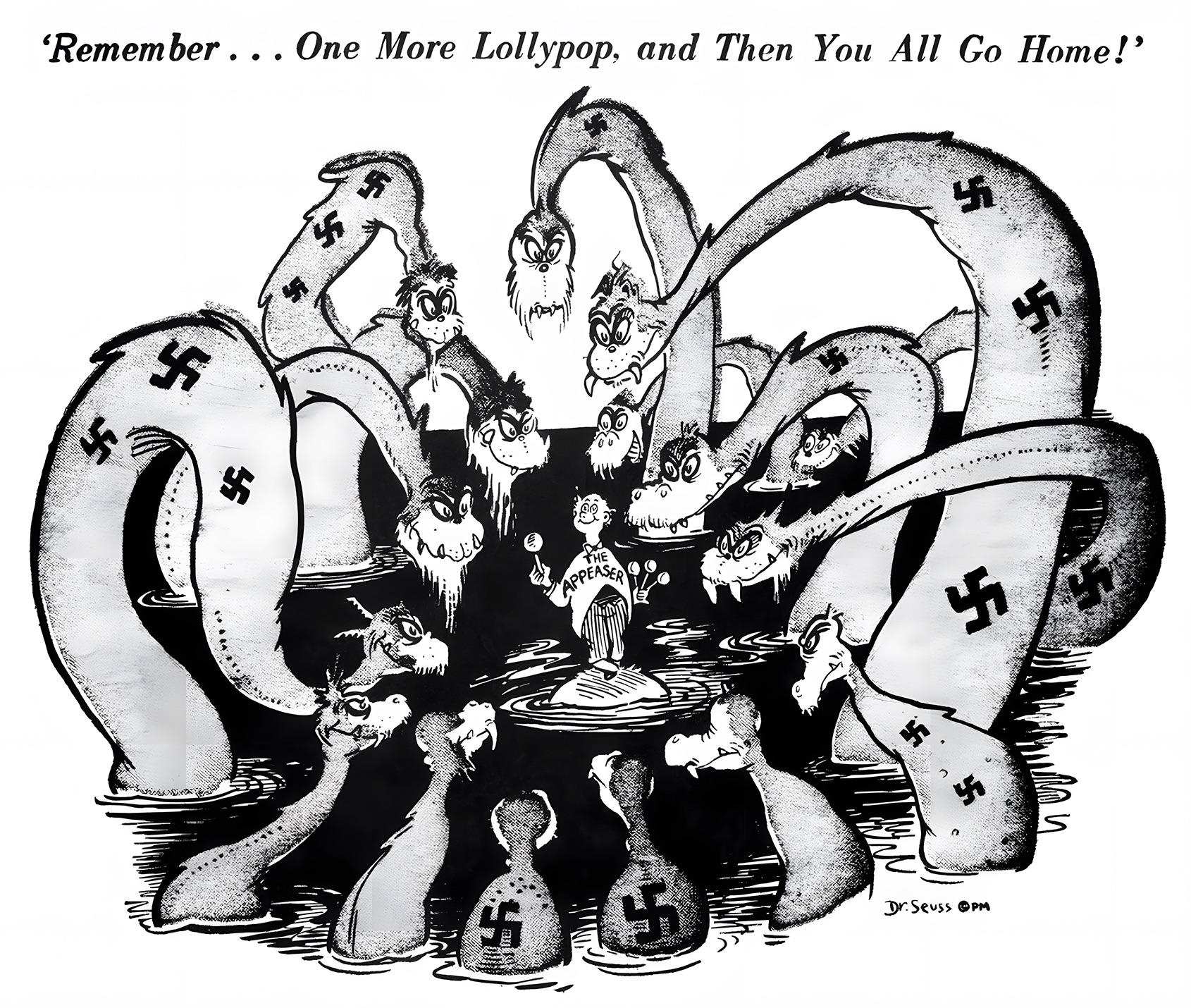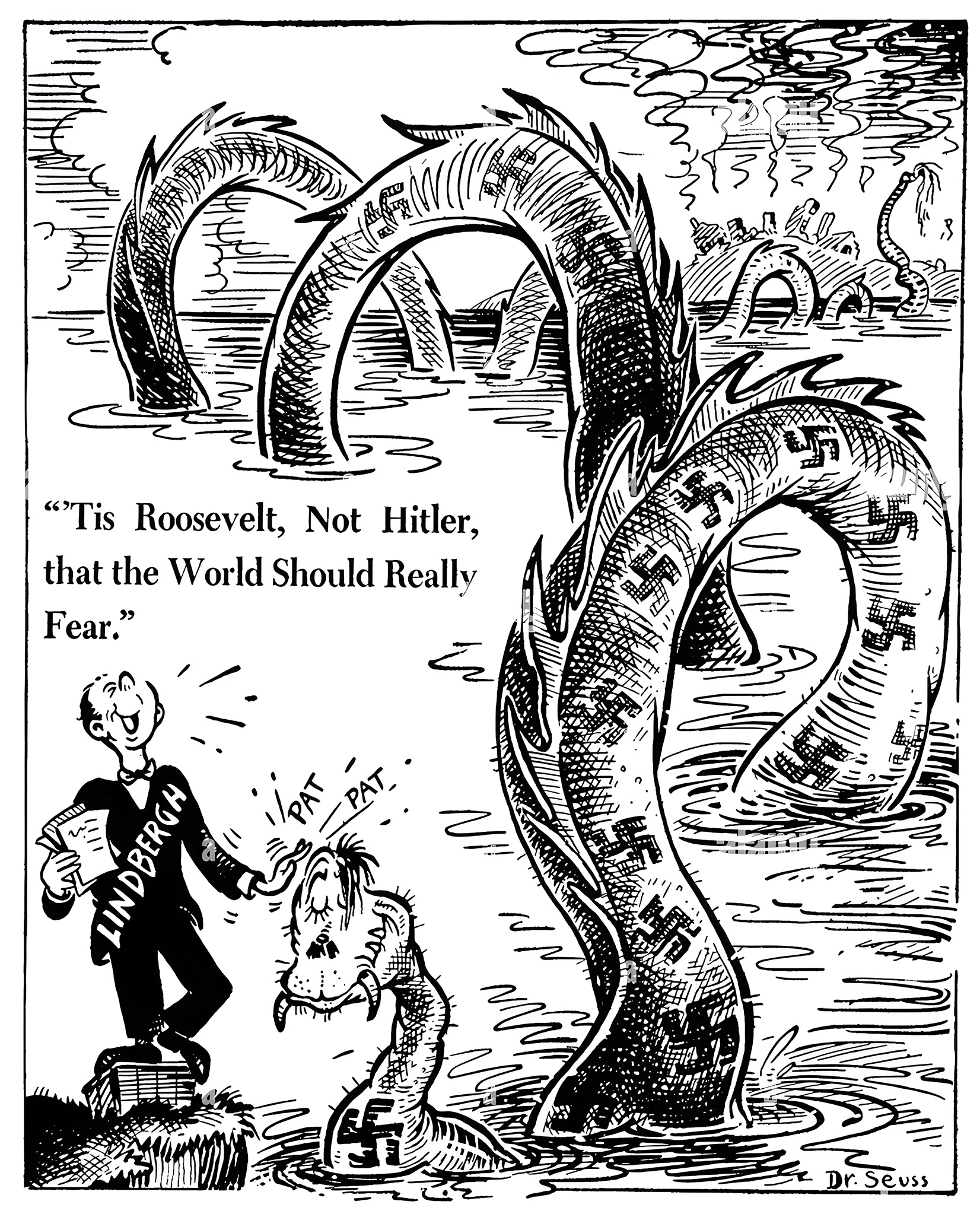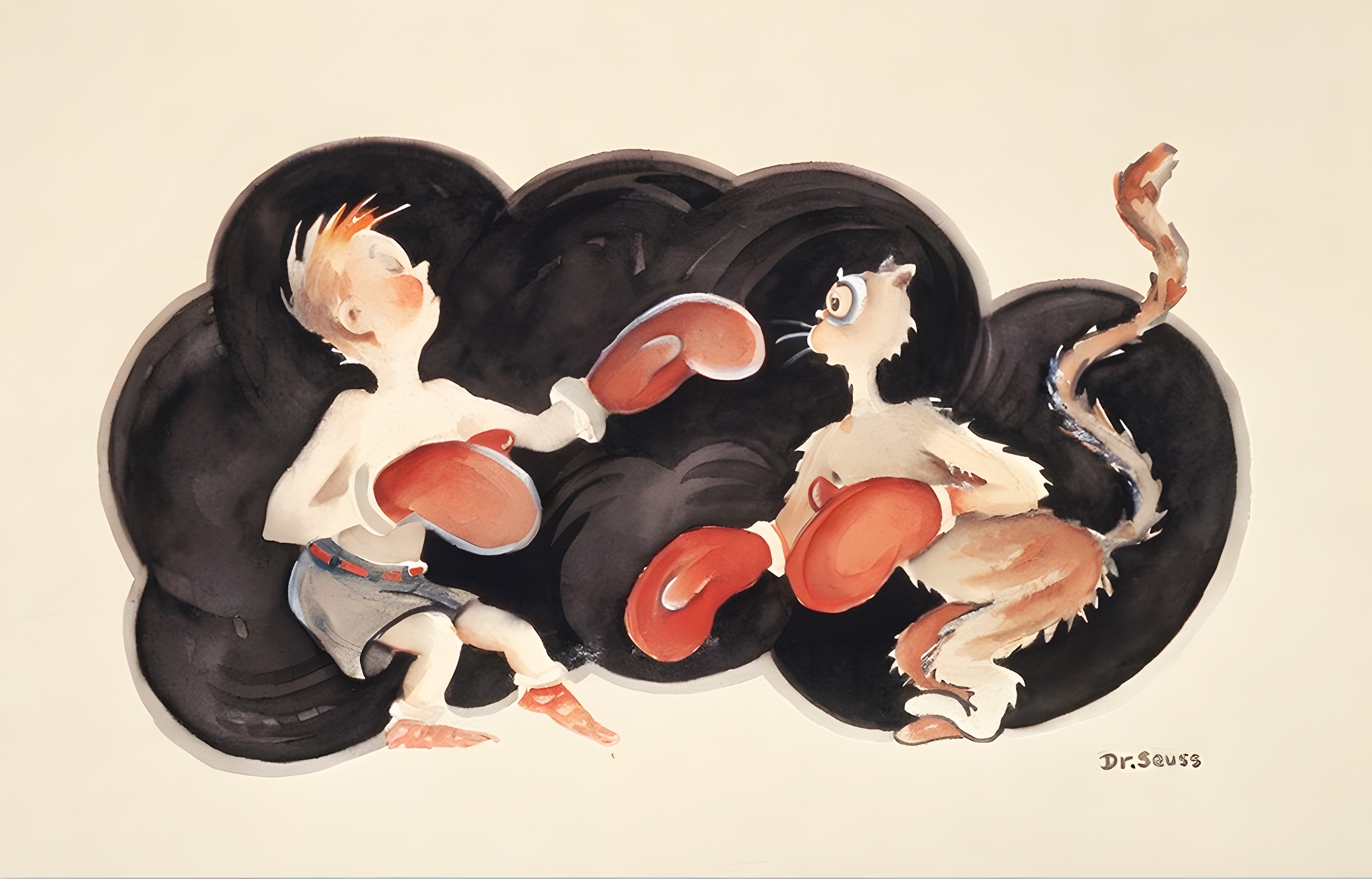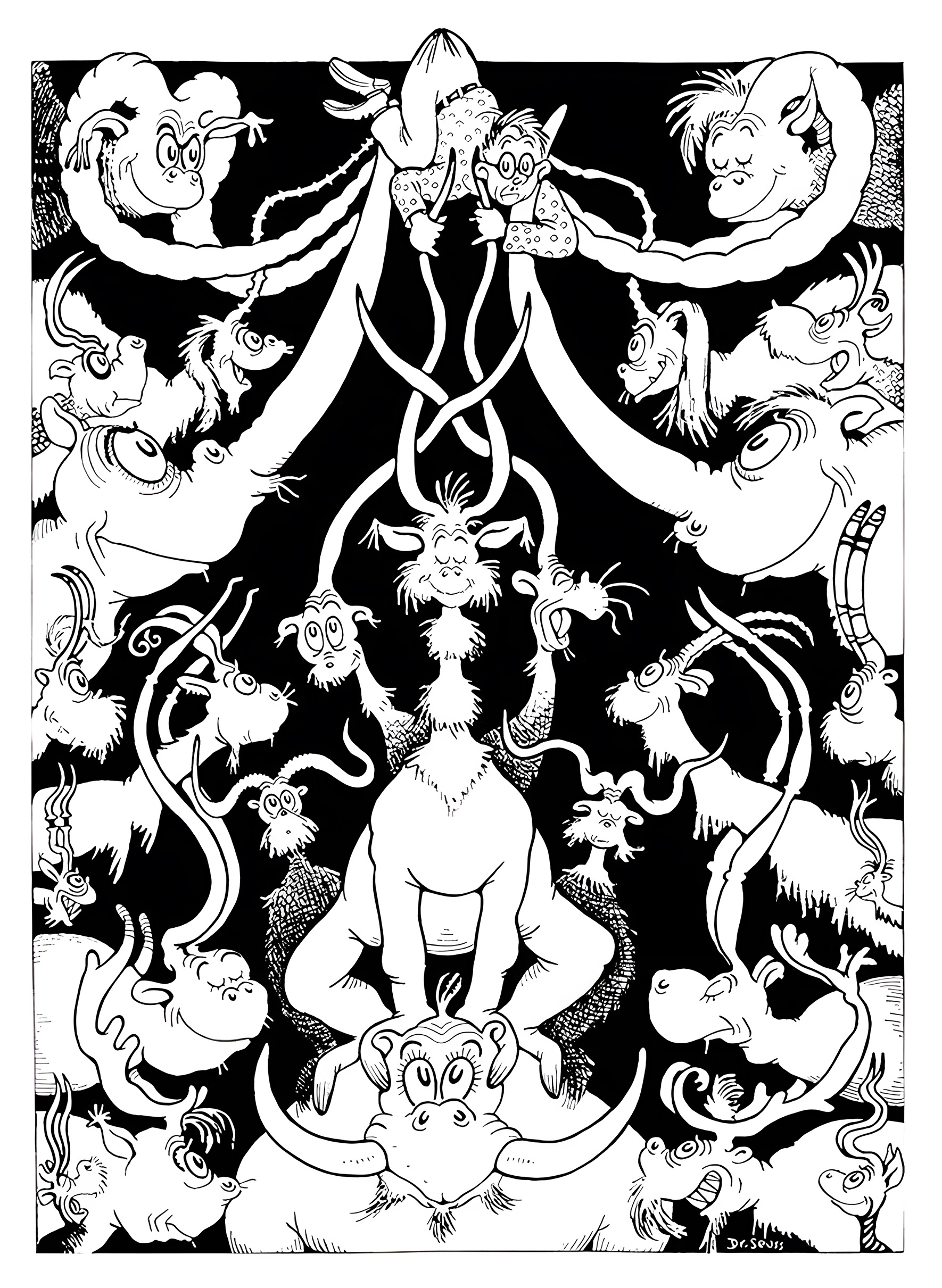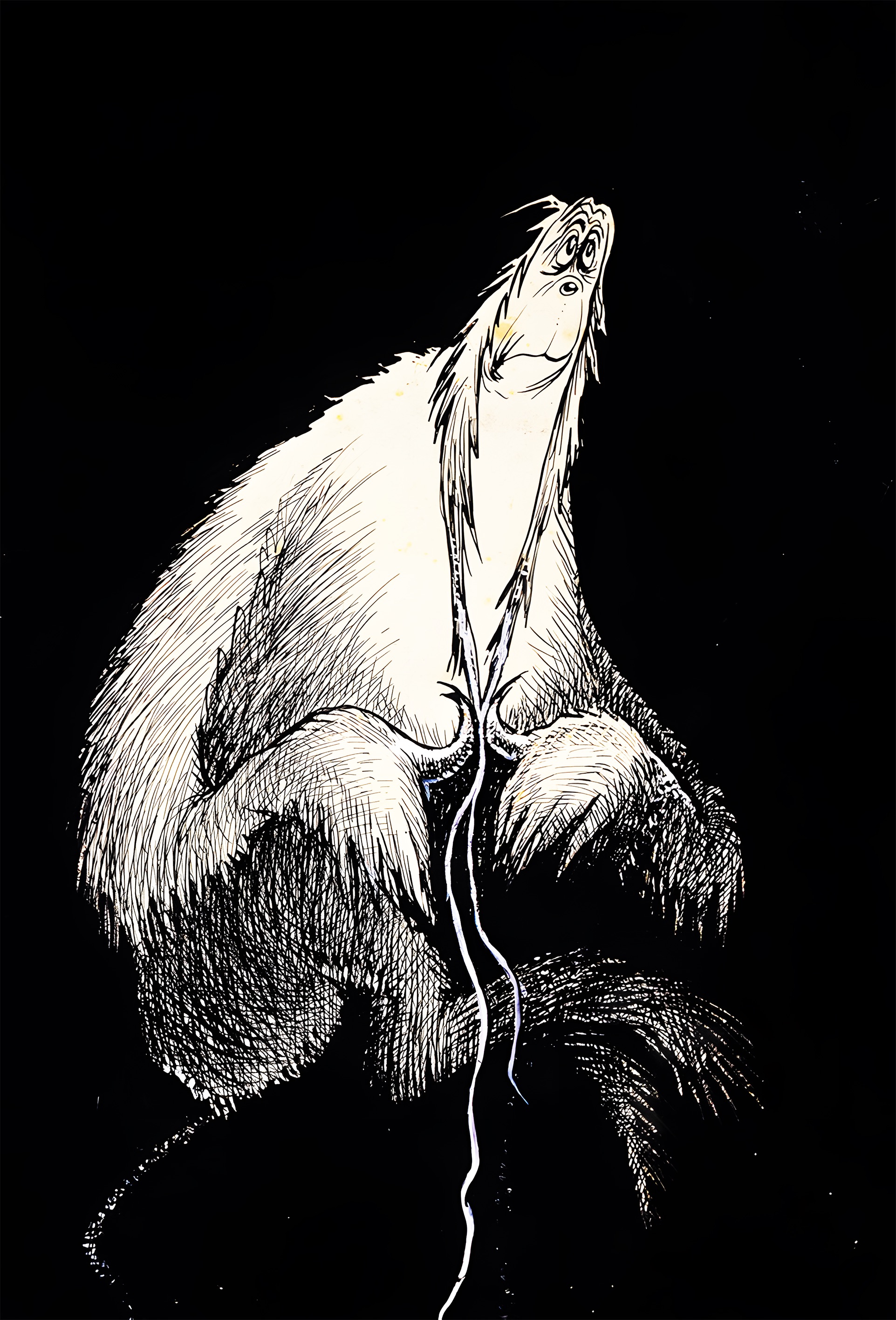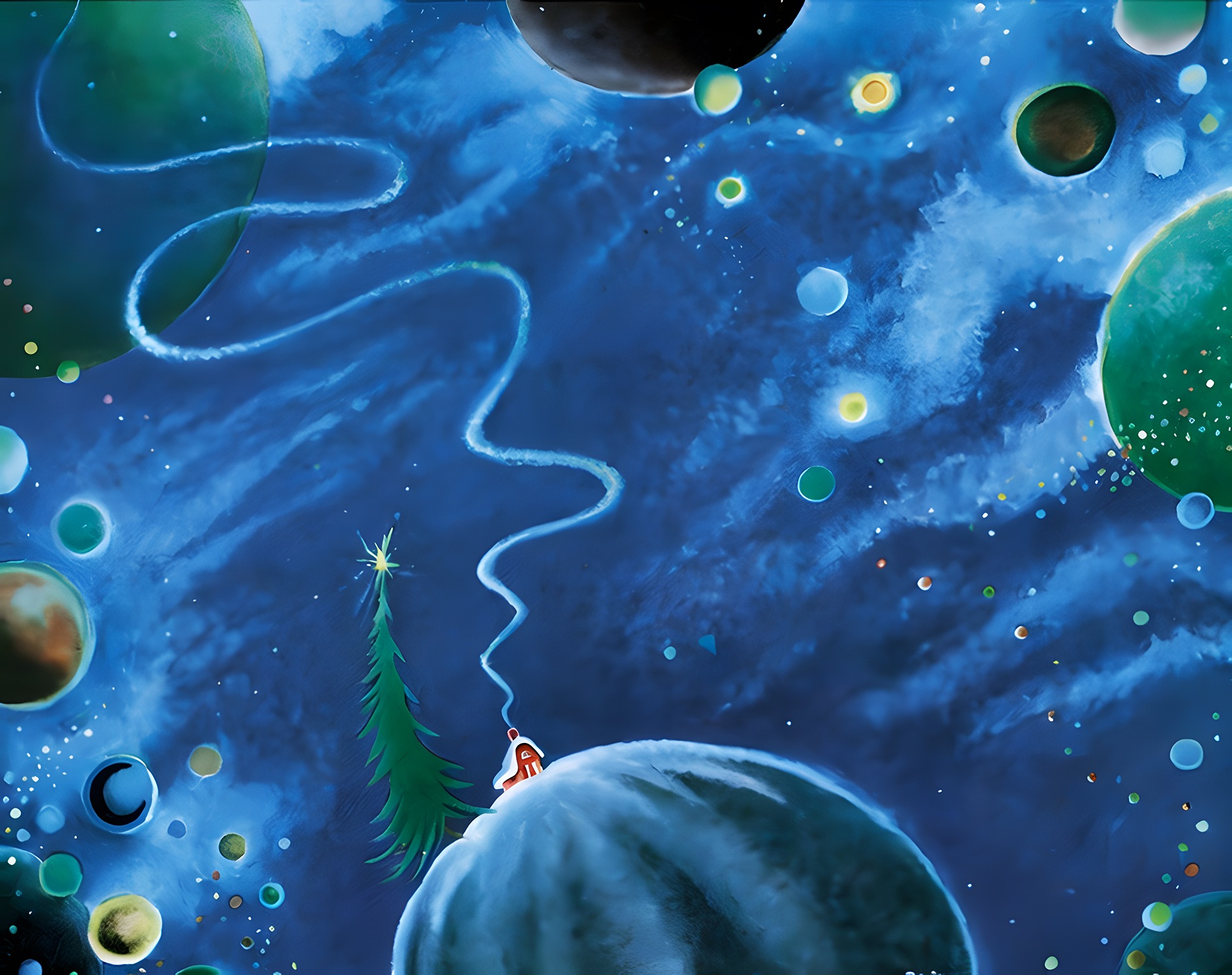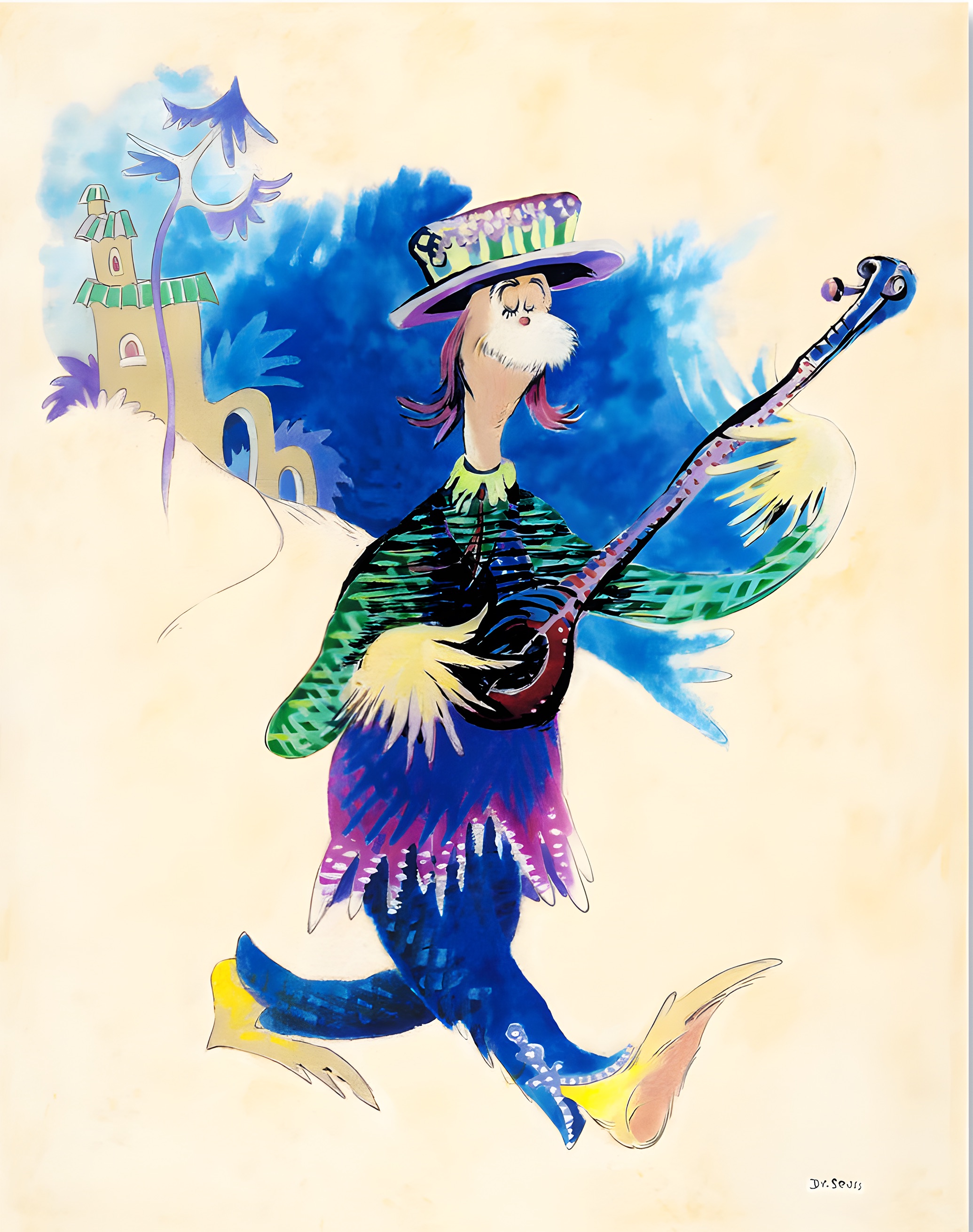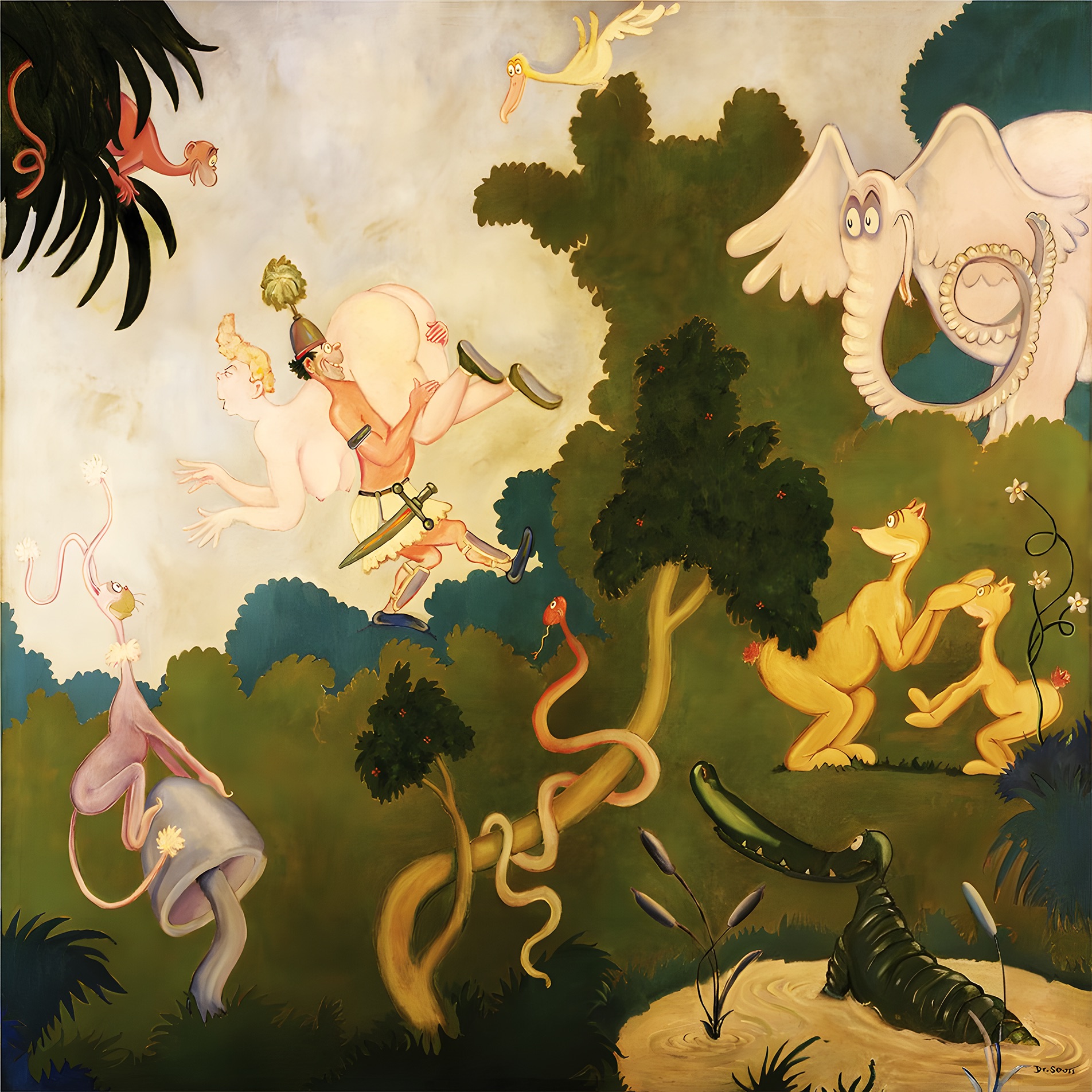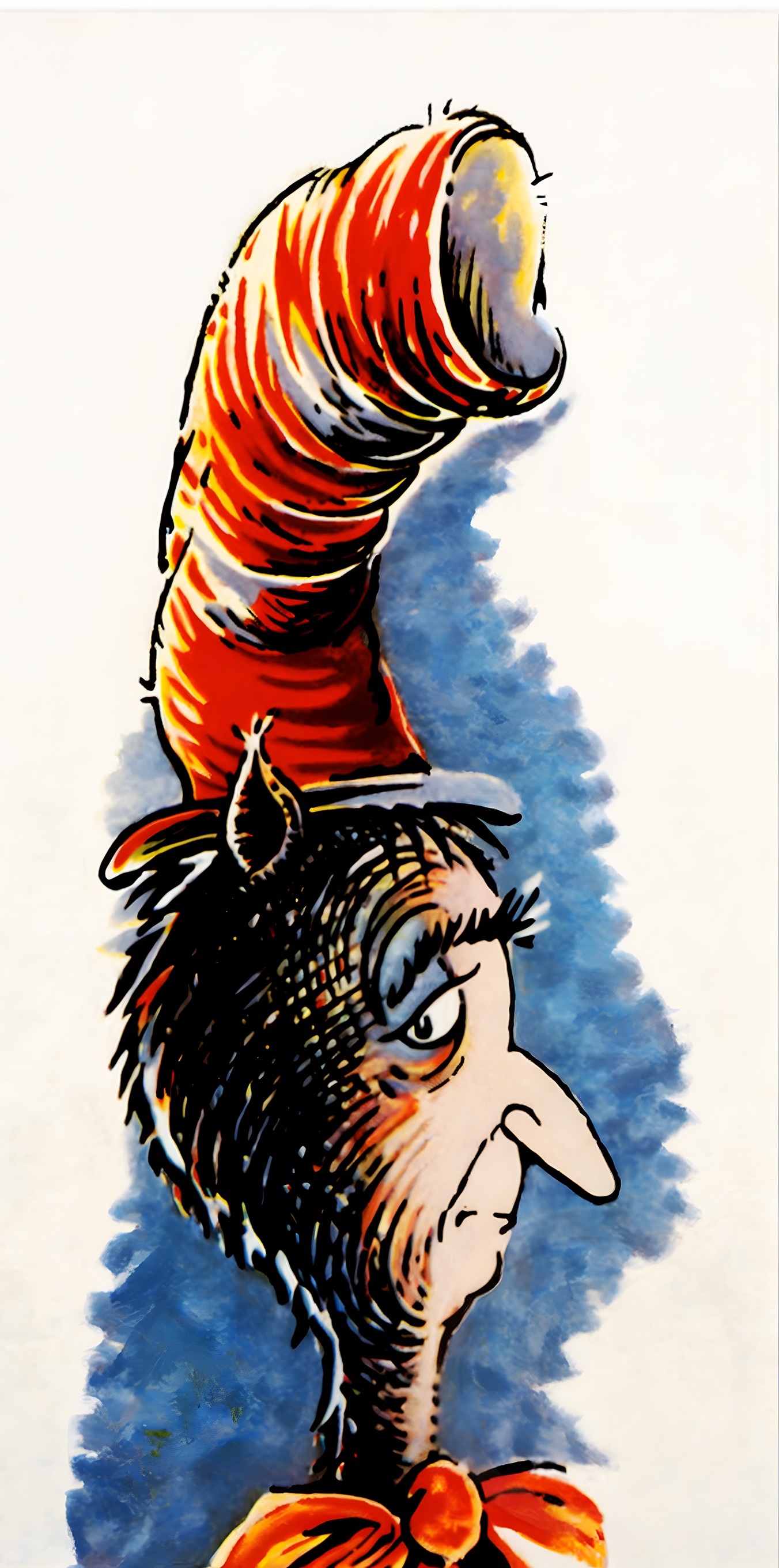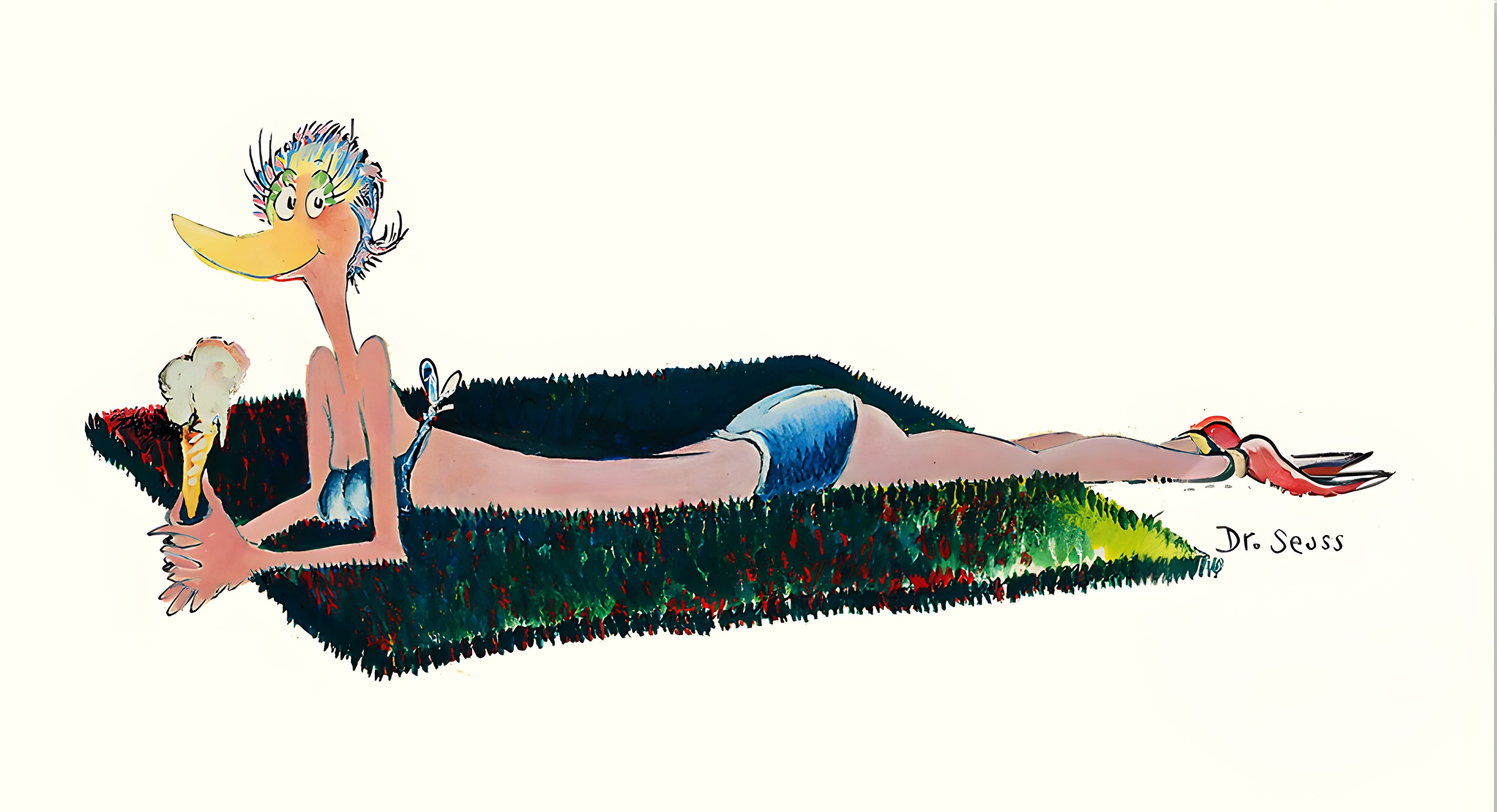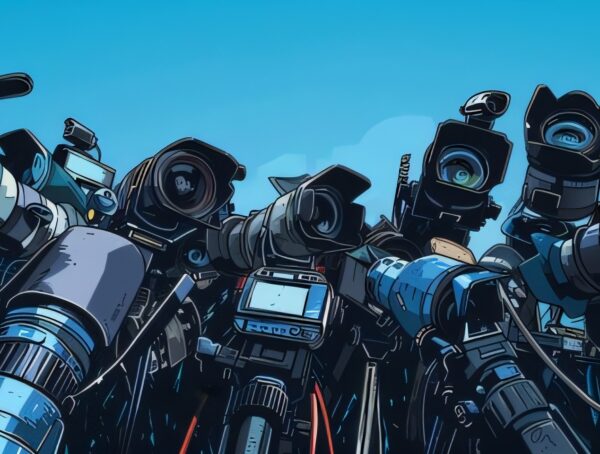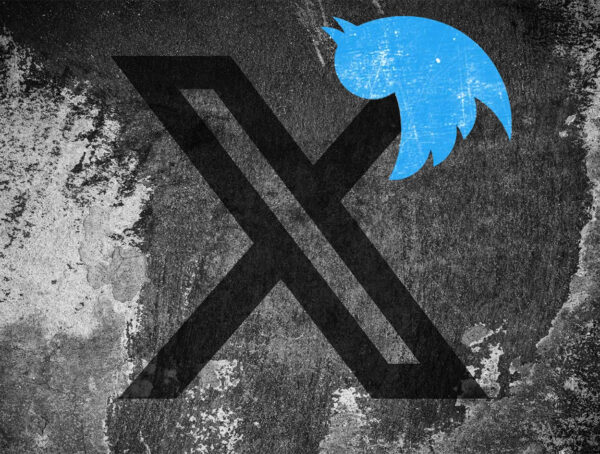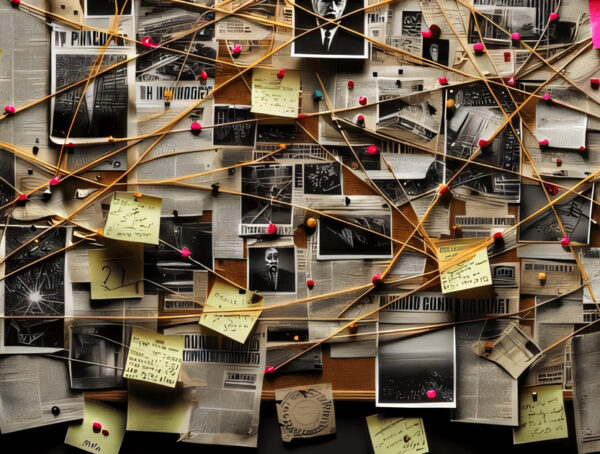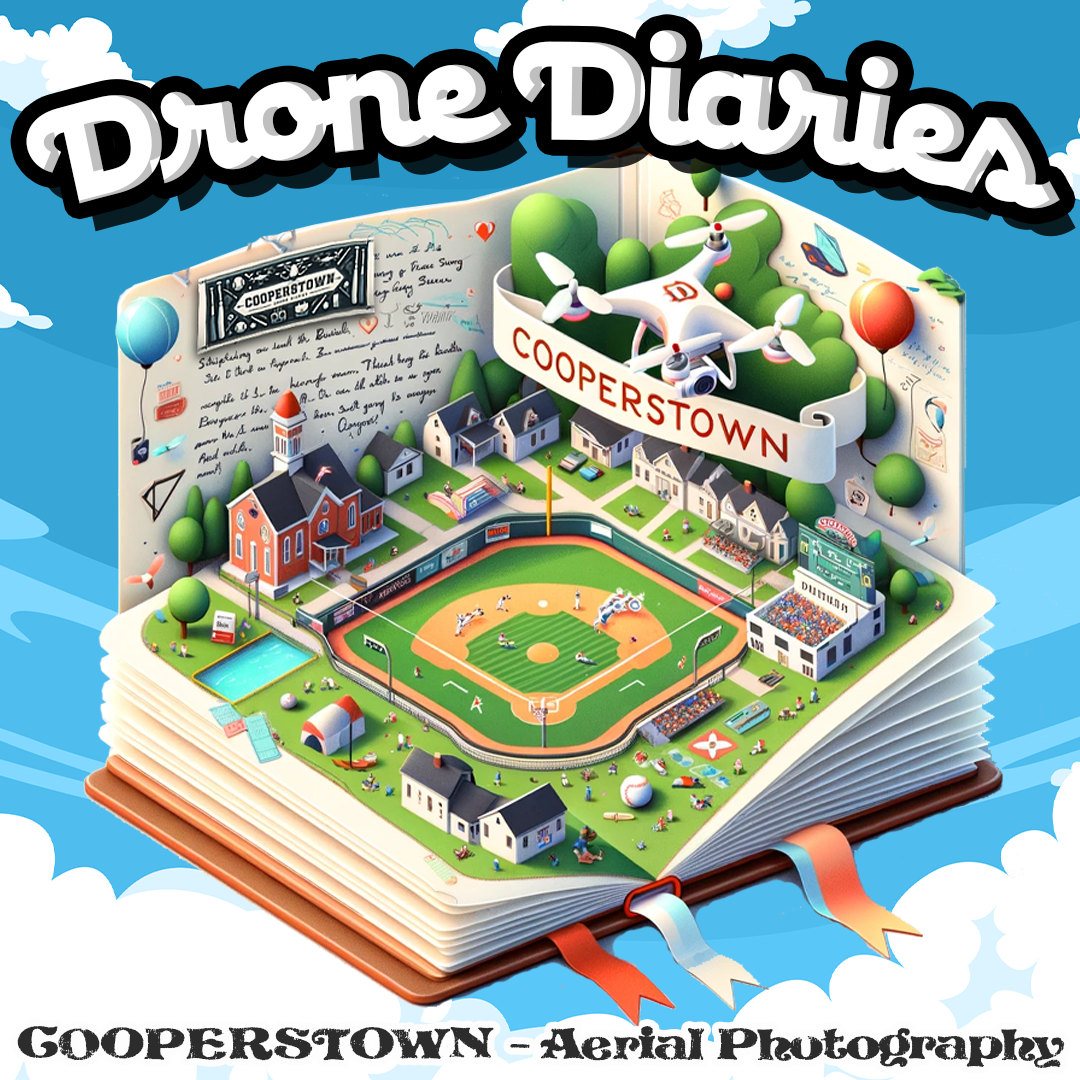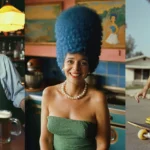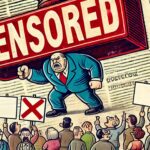The Seuss You Were Never Meant to See
Dr. Seuss is a sacred cow in American culture. His name evokes grins, giggles, and moral lessons wrapped in rhyme. But beneath the Cat in the Hat and the Grinch lies something far more complex and, frankly, uncomfortable. Long before he was America’s bedtime bard, Theodor Geisel was a sharp-tongued political cartoonist, an experimental surrealist, and yes, at times, a vessel of racial caricature and raw psychological depth.
This isn’t the Seuss your school librarian taught you about. This is the other Seuss. The one who drew lynched Jews hanging from trees. The one who turned Hitler into a taxidermist and Charles Lindbergh into a traitor. The one who painted a bikini-clad bird-woman seductively licking an ice cream cone. You may want to look away. But you shouldn’t.
Whimsy Meets War, Sex, and Sadness
We’ve been sold a sanitized myth. That Seuss was only playful. That his creatures only taught kindness and inclusion. But the man behind the rhymes was far more haunted than his rhyming cadence ever let on.
Behind closed doors, he painted monsters that couldn’t be tamed and characters that wrestled with identity, vanity, and eroticism. He drew America’s sins with the same pen he used to draw Whoville. And here’s the truth nobody likes to say out loud: the most honest version of Dr. Seuss may be the one that was never published.
Wartime Propaganda and the Ugly Truth
Before he taught kids to count fish or hop on pop, Dr. Seuss was churning out some of the nastiest propaganda of World War II. And it wasn’t subtle. It was racist, dehumanizing, and weaponized without apology. If you think the man who gave us Horton Hears a Who was always the moral compass we pretend he was today, you’re about to get a harsh reality check.
🧨 Wipe That Sneer Off His Face!
This piece is pure, unfiltered WWII propaganda. A grinning Japanese military figure, likely General Tojo, smirks from the page, daring Americans to do something about it. The caption demands the public buy war bonds and “wipe that sneer off his face.”
Dr. Seuss knew exactly what he was doing: rallying Americans through hatred and mockery. It wasn’t subtle, and it wasn’t innocent. It was racial caricature weaponized for patriotism, a crude battering ram for national morale. Later in life, Seuss tried to distance himself from this period, but ink doesn’t come with an eraser and what he drew here stuck forever.
Observation:
Seuss didn’t just demonize the Japanese military, he made sure to flatten their humanity altogether. In his world, the enemy wasn’t complex or conflicted. They were cartoon villains, sneering targets to be destroyed. In wartime, that wasn’t a bug, it was the whole design.
📛 Flit Comic: The One That’s Impossible to Defend
Before he became a children’s icon, Seuss spent years shilling for a bug spray company called Flit. And here’s the result: grotesque caricatures of Africans so cartoonishly racist they practically humiliate themselves.
This isn’t a product of “different times” it’s a symptom of an entire culture comfortable with dehumanizing others for a quick laugh and a paycheck. Seuss cashed Standard Oil’s checks while drawing tribal “savages” trying to boil white explorers alive. It’s a stain on his legacy, and pretending it didn’t happen doesn’t make it go away. The man who taught your kids to celebrate Sneetches drew blackface cartoons without a second thought.
Fact:
Before he was “Dr. Seuss,” Theodor Geisel made his living off corporate ads, drawing racist caricatures to sell insecticide. The Flit campaign is where he first perfected the style, fast, loud, and grotesque, that later made him a children’s icon. Morality didn’t come first. Money did.
🐱 Jap Alley: Racism in Propaganda, Plain and Ugly
This cartoon isn’t satire. It isn’t nuance. It’s just raw, ugly racism served up with a smile and a baseball bat.
Uncle Sam, armed and smirking, stands atop a stoop while swarms of Japanese “cats” flood an alleyway below. The message? Japanese-Americans were pests to be managed, not citizens to be protected. Seuss’s pen helped fuel the paranoia that led to 120,000 American citizens being herded into internment camps. That’s not wartime necessity, that’s moral failure dressed up as patriotism.
Observation:
The same guy who later preached tolerance with the Sneetches helped grease the wheels for Japanese internment camps by depicting fellow Americans as vermin. Seuss didn’t just “go along” with the racism of the times, he fed it.
🪓 Only God Can Make a Tree: Hanging Jews in the Forest of Fascism
This cartoon isn’t just dark, it’s gut-wrenching. Nazis hang Jews from trees like gruesome ornaments while Hitler and Vichy collaborator Pierre Laval merrily admire the scene.
The caption, “Only God can make a tree… to furnish sport for you and me” bleeds sarcasm and condemnation. It’s a brutal reminder that genocide wasn’t hidden. It wasn’t quiet. It was cheered by those who profited from it. And Seuss, to his credit, didn’t flinch from showing the West exactly how complicit it was in letting it happen.
Fact:
This cartoon ran before most Americans even acknowledged the full scale of the Holocaust. Seuss wasn’t just following the news, he was screaming it in ink while the rest of the world plugged its ears.
🏛 Hitler’s Trophy Room: The Taxidermist of Europe
A hunter’s den, but the prizes aren’t animals, they’re countries. France, Poland, Norway, Romani, all stuffed and mounted on Hitler’s wall like grim hunting trophies.
Seuss’s message wasn’t subtle: Europe wasn’t being defeated in battle; it was being gutted, preserved, and paraded. This was what appeasement had built, a continent full of corpses proudly displayed on a dictator’s mantle. While politicians gave speeches, Hitler collected heads.
Observation:
It’s easy to call Hitler evil now. It wasn’t easy in 1940, when most of Europe still thought he could be bargained with. Seuss didn’t have patience for that fantasy, he knew exactly what they were feeding, and what it would cost.
🍭 One More Lollipop… Appeasement Is Suicide
You don’t fight monsters by feeding them candy. But that’s exactly what Seuss shows here: an “Appeaser” surrounded by swastika-toting snake monsters, handing out lollipops and asking politely for peace.
Seuss was hammering the so-called diplomats who thought evil could be reasoned with. Neville Chamberlain didn’t bring peace to Europe, he handed Hitler a bloody lollipop and pretended it was a treaty. Feeding evil just emboldens it, and Seuss knew it.
Fact:
Seuss created dozens of cartoons mocking Neville Chamberlain directly. In his eyes, the British Prime Minister wasn’t just a coward, he was an enabler who practically gift-wrapped Europe for Hitler. History, unfortunately, agreed.
🐉 It’s Not Hitler We Should Fear: Seuss vs. Lindbergh
Charles Lindbergh, the golden boy of American aviation, is shown patting a Nazi sea monster like a loyal dog. Meanwhile, he blames Roosevelt for the world’s problems instead of the fascist regime actually tearing it apart.
Seuss wasn’t fooled by Lindbergh’s fake neutrality. He saw isolationism for what it was: cowardice masquerading as principle. You don’t get to be neutral while monsters slaughter civilians. You either stand up, or you get swallowed.
Fact:
Charles Lindbergh was a public darling, a celebrity, a hero, and a national embarrassment. He openly opposed U.S. involvement in WWII and blamed “the British, the Jews, and the Roosevelt administration” for pushing America toward war. Seuss didn’t just criticize him. He burned the myth of Lindbergh to the ground.
🎁 Put Your Finger Here, Pal: The Gift of Race Hatred
Hitler, grinning like a door-to-door salesman, offers a package labeled “Race Hatred” to a willing American anti-Semite. He doesn’t have to shove it in their hands. They’re reaching for the ribbon themselves.
Seuss knew that the fight against evil wasn’t just happening in Europe. It was happening on American soil, in the hearts of citizens who cloaked bigotry under the banners of patriotism and tradition. Fighting Nazis abroad while nursing racism at home was hypocrisy of the highest order, and Seuss had the guts to say it.
Observation:
The ugliest truth Seuss drew was that racism wasn’t imported from Germany, it was already thriving here, homegrown and smiling. Hitler didn’t need to infiltrate American minds. He found willing partners.
Psychological Warfare: Seuss vs. Himself
Peel back the war years, and what you find isn’t relief or redemption. It’s a man increasingly at war with himself. In these works, Seuss isn’t taking aim at Nazis or politician, he’s sketching the slow-motion collapse happening inside his own soul. The monsters aren’t out there anymore. They’re wearing his face.
🥊 Boy vs. Cat: Inner Conflict in Watercolor
At first glance, it’s charming. A little boy with boxing gloves squares off against a wiry cat. There’s no background, no buildup, just a weird, frozen standoff.
But stare a little longer and the real picture emerges: innocence versus chaos. The boy, fists raised, isn’t playing. He’s bracing for a real fight. The cat, wild-eyed and unpredictable, isn’t just a foe, it’s every ounce of temptation, mischief, and rebellion a child has to battle. Seuss knew the fight to grow up clean wasn’t against the world. It was against yourself.
Observation:
Seuss wasn’t drawing a boy boxing a cat. He was drawing the war inside every man, the fight between order and chaos, between impulse and responsibility. Childhood wasn’t innocent to Seuss. It was a battlefield.
🧶 Cat in the Cradle Doing Cat’s Cradle: Seuss Goes Meta
Cute, right? A literal cat in a cradle playing cat’s cradle with a piece of string. Seuss doing what he always did: spinning words into whimsical pictures.
But like a lot of Seuss’s private work, it turns hollow if you look too hard. There’s no kid in the cradle. No parent nearby. Just a lonely cat entertaining itself with something it barely understands. It’s funny until you realize it’s also a portrait of aging, isolation, and life slipping past while you busy yourself with games. Seuss wasn’t just playing with puns here. He was holding up a mirror and daring you to laugh before you cry.
Fact:
Seuss loved puns, but he hated sentimentality. His private paintings, like this one, often took “cute” ideas and twisted them into images of sadness, loneliness, and missed connections. A cradle without a baby was no accident.
🐐 If You Thought Your Family Was Complicated…
Here’s where the chaos really leaks out. A beast, part goat, part disaster, stands at the center while limbs, horns, and appendages whip around like a tornado.
This is family, responsibility, life, the whole ugly, tangled mess. Every obligation pulling in a different direction. Every mistake multiplying until you can’t even see what you used to be underneath the noise. Seuss didn’t draw “dilemmas” as logical puzzles to solve. He drew them as nightmares you endure, smiling awkwardly as the walls buckle around you.
Observation:
This isn’t just surrealism. It’s realism through a funhouse mirror. Families don’t fall apart in a straight line. They tangle themselves up, limb over limb, until nobody knows whose fight started what.
🦍 Lonely Creature with Cord: Existential Despair in Ink
A single figure, hulking and alone, sits holding a limp string against a black void. No background. No color. No audience.
This isn’t art for kids. This isn’t even art for adults who still think the world’s supposed to make sense. This is depression on canvas. A soul left dangling, still clutching onto something, but nobody, not even the artist, can tell you what that “something” is. It’s brutal in its simplicity. And it’s exactly the kind of honesty modern culture is too fragile to face.
Fact:
Seuss battled depression most of his adult life, but kept it hidden beneath a public persona of whimsical joy. This image, a single creature holding onto a pointless cord, is the rawest confession he ever made without words.
🌌 House, Tree, and Smoke Trail in Space: Cosmic Seuss
Now for something different, but no less jarring. A lone red house and a leafless tree perch on a marble-sized planet, spinning in a black swirl of stars.
It’s whimsical, sure, but the loneliness is deafening. A house built where no one will ever find it. A tree growing where no one will ever sit in its shade. Seuss’s space isn’t full of wonder. It’s a place of exile. A monument to what happens when you build beautiful things and realize, too late, there’s nobody left to share them with.
Observation:
If you think Seuss painted that red house to be cute, you missed the whole point. A house floating in empty space isn’t a home. It’s a warning: create all you want, but without connection, it all floats off into the void.
🎸 Untitled Musician: Seuss’s Late-Night Alter Ego
Now we see Seuss in full escape mode. A cartoonish figure, decked in psychedelic patterns, strums a guitar in a surreal, free-floating dreamscape. It’s loose, it’s weird, and it’s wildly unlike the polished kids’ books he became famous for.
This is what happens when the guardrails come off. No publishers. No deadlines. No moral messaging for children. Just a man letting the strange parts of his mind run barefoot through the studio at midnight. It’s creativity unchained, and just chaotic enough to make you wonder if the Seuss you thought you knew was always wearing a mask.
The Secret Art: Sex, Vanity, and Surrealism
If you think Dr. Seuss’s secret paintings are just playful experiments, you’re wrong. What he locked away in his private collection was a raw, bizarre, and sometimes deeply uncomfortable exploration of human nature. Lust, loneliness, madness, nothing was too sacred or too weird to touch. This is Seuss with the filter ripped off. Brace yourself.
Fact:
Seuss created an entire private art collection he refused to show publicly during his lifetime. He called it his “Midnight Paintings”, not because they were literal, but because they revealed the parts of him that only came out after the lights were off.
🍑 Rape of the Sabine Women: Seuss Goes Surreal
The title alone should tell you: this isn’t Dr. Seuss cuddling the edges of taboo. It’s him diving headfirst into it. A Roman soldier hauls off a multi-limbed nude figure, framed by bizarre, writhing creatures watching passively.
There’s nothing playful here. This is historical violence, rewritten in a surreal fever dream. Seuss wasn’t trying to entertain you. He was holding up ancient brutality and showing how it never really changes, how societies, from Rome to modernity, still dress up their savagery in pretty language and pretend it’s necessary. It’s grotesque, uncomfortable, and brutally honest. Which, ironically, makes it more moral than anything you’ll see on cable news today.
Observation:
When Seuss touched taboo, he didn’t clean it up for public consumption. He leaned into it. He forced viewers to see the ugliness of histor, not as legend, but as the grotesque, bloody farce it really was.
🎩 Cat in the Hat, Deconstructed: The Sad Clown of Seuss
Here’s the Cat in the Hat, but the grin is gone. The colors are muted. The eyes are empty. This isn’t a trickster causing mischief. It’s a sad clown putting on a costume for a world that stopped laughing a long time ago.
This is Seuss without the mask. The exhausted entertainer who spent his life crafting joy for others while wondering if he ever really caught any for himself. This isn’t just a portrait. It’s a confession. And it’s more honest than a thousand chirpy verses about hopping on pop.
Fact:
The Cat in the Hat was born partly from a business mandat, publishers wanted a funnier, livelier reading primer. But behind the forced smiles and goofy stunts, Seuss’s Cat was always a little bit broken. He drew what the market demanded. But he painted what he actually felt.
🪒 Morning Routine: Vanity in the Mirror of Madness
A gangly, half-naked figure stares into a cracked, twisted mirror while shaving. Around him, the room warps and bends like a funhouse from hell.
What Seuss captured here is the most brutal kind of vanity, the desperate, hollow kind. The need to maintain appearances while the world and maybe your own mind, falls apart around you. We dress ourselves up every morning like everything’s fine, but the mirror knows better. It always does. And sometimes the greatest joke isn’t what you see, it’s that you keep pretending to believe it.
Observation:
This isn’t just a portrait of madness. It’s a mirror most people refuse to look into. We all pretend that shaving, dressing up, and smiling means we’re stable. Deep down, we all know the mirror is lying, and so are we.
🍦 Bikini Bird with Ice Cream: Seuss Gets a Little Saucy
And just when you think you’ve seen all sides of Seuss, he throws this curveball: a tall, birdlike woman in a bikini, stretched out in the sun, licking an ice cream cone with a look that’s anything but innocent.
It’s flirty. It’s satirical. And it’s absolutely, unapologetically weird. Seuss had a playful, risqué streak that never fit the brand-safe image built around him later. This isn’t about shock value, it’s about acknowledging that even the “good guys” of our culture have instincts and urges they’d rather not explain to polite company. And maybe, deep down, that’s the most honest thing he ever put on paper.
Fact:
In his private works, Seuss often played with sexuality, exaggerating bodies and poses to the point of absurdity. He wasn’t moralizing about lust, he was mocking how ridiculous our attempts to tame it usually look.
What Seuss Was Really Warning Us About
You can dismiss this art as relics of their time. Or you can do what most people are too cowardly to do, confront it. Seuss wasn’t just entertaining kids. He was diagnosing a sick culture with ink. Whether through satirical venom or surreal introspection, he was warning us, about appeasement, about propaganda, about moral cowardice dressed up as politeness.
This work isn’t comfortable. It’s not supposed to be. But it’s necessary, because the same forces he mocked still exist. They’ve just traded swastikas for hashtags and lollipops for likes.
Cancel the Lie, Not the Artist
So what do we do with this version of Dr. Seuss? We don’t cancel him. We don’t whitewash him. We tell the truth. Because in the end, the legacy of Seuss isn’t just that he taught kids to read, it’s that he held a funhouse mirror to our culture and dared us to laugh at our own reflection.
And if that reflection still makes you uncomfortable… good. Maybe you’re finally seeing the real picture.
More from Informative
Why You Can’t Trust the News Anymore
In today’s media landscape, the illusion of an unbiased, purely journalistic fourth estate is as believable as a late-night infomercial …
How the Pros Use X: Tweeting Tactics for Explosive Growth
The Hidden Science of X's Tweet Visibility Most users assume their tweets are simply tossed into the mix, waiting to be …
Conspiracy Theories That Came True
Conspiracy theories used to be the stuff of unsourced whispers in poorly lit basements, but in today's internet age, they've …







